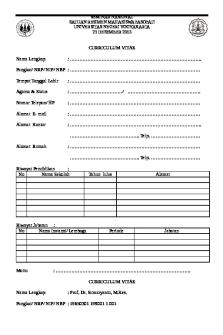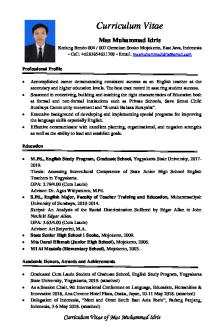CV Arrhythmias notes PDF

| Title | CV Arrhythmias notes |
|---|---|
| Course | ISCM Cardiorespiratory Block |
| Institution | University of Central Lancashire |
| Pages | 12 |
| File Size | 630.9 KB |
| File Type | |
| Total Downloads | 550 |
| Total Views | 1,001 |
Summary
13.CV ARRHYTHMIAS1. CARDIAC ELECTRICAL ACTIVITY2. CARDIAC MYOCYTE AP3. CARDIAC NODAL AP4. ELECTROCARDIOGRAM5. DYSRHYTHMIA CLASSIFICATIONS6. CAUSES OF ARRHYTHMIAA. After-polarisation: i. Abnormally high [Ca2+]i triggering trains of Aps. Often causes ectopic beats. B. Re-entry: i. Impulse re-excites p...
Description
13.12.18
CV ARRHYTHMIAS 1. CARDIAC ELECTRICAL ACTIVITY
2. CARDIAC MYOCYTE AP
3. CARDIAC NODAL AP
4. ELECTROCARDIOGRAM
5. DYSRHYTHMIA CLASSIFICATIONS
6. CAUSES OF ARRHYTHMIA A. After-polarisation: i. B.
Abnormally high [Ca2+]i triggering trains of Aps. Often causes ectopic beats. Re-entry:
i. C.
Impulse re-excites previously active tissue; AP circulation. Often associated with damaged heart tissue Ectopic pacemaker activity:
i.
Excessive automaticity; overactivity of nodes or ectopic activity outside nodes
7. TRIGGERED ACTIVITY
2
8. RE-ENTRY
9. EXCESSIVE AUTOMATICITY
10.
OLD SCHOOL CARDIAC PARMACOLOGY Vaughan-Williams classification (1970s; outdated). Define by electrophysiological effects. A. Class I (a, b, c): VG Na+ channel blockers B. Class II: Anti-sympathetic (“beta blockers”) C. Class III: VG K+ channel blockers D. Class IV: VG Ca2+ blockers E. Class V: Anything else (e.g. digoxin, adenosine)
11.
CLASS 1 MOAS Block VG Na+ channel – main effect to slow AP conduction in myocytes
3
Na + CHANNEL BLOCKER USE DEPENDENCY
12.
A. The faster the cell fires Aps, the more drug binds and slows AP generation B. Therefore, minimal effect at low heart rate
13.
CLASS 1A MOA A. Quinidine (classic, but obsolete) – high TdP risk B. Procainamide (obsolete) C. Disopyramide:
14.
i.
Can be used for atrial & ventricular tachycardias
ii.
Anticholinergic side effects (especially disopyramide)
iii.
Negative inotropic effect (= reduced contractility) due to ↓ Ca2+ entry: avoid with hypotension or low ventricular output
CLASS 1B DRUGS A. Lidocaine (IV only; also used as local anaesthetic) B. Mexiletine (orally available, rare in UK) C. Tocainide (obsolete) D. Rapid dissociation means little effect except at fast heart rates E. Used for ventricular tachycardia & fibrillation; minimal effectiveness for atrial tachycardias
4
15.
CLASS 1C MOA A. Rapid dissociation means little effect except at fast heart rates B. Used for ventricular tachycardia & fibrillation; minimal effectiveness for atrial tachycardias C. Used for atrial fibrillations and ventricular tachycardia (AV nodal re-entrant tachycardia) D. Potent negative inotropes – risk of heart failure if weak heart
16.
CLASS 2 MOA Adrenergic b receptor antagonism: ↓ cAMP, ↓ Ca2+ (possibly also ↓ Na+?)
17.
CLASS II DRUGS: “BETA-BLOCKERS” Reduce mortality following MI; reduce arrhythmias due to excessive sympathetic activity A. Propranolol (has some class I activity) B. Sotalol (some class III activity) C. …lol (many others, although often not favoured for arrhythmias) D. Side effects:
5
i.
Dizziness, fatigue, hypotension, nausea, diarrhoea, peripheral vasoconstriction
ii.
Sotalol may be more potent where class III effects useful, but should otherwise be avoided (e.g. TdP risk)
18.
CLASS III: MOA Block K+ channels. Reverse use dependency – potentially pro-arrhythmic in bradycardia. A. Effect on myocyte (& nodal) AP: i.
Delays repolarisation (phase 3)
ii.
Negative chronotropic, positive inotropic
B. Class III drugs are highly effective although also have severe side effects
19.
CLASS III DRUGS A. Amiodarone (has some class 1a, class II & class IV activity) i.
Toxicity (lungs, liver), thyroid dysfunction, TdP, skin discolouration & photosensitivity
B. Dronedarone similar to amiodarone but less lipophilic & safer. C. Sotalol; less effective class III effects D. Use in atrial & ventricular tachycardias (usually when patients refractory to other drugs); Wolfe-Parkinson-White syndrome
20.
WOLFE-PARKINSON-WHITE SYNDROME
6
21.
CLASS IV: MOA Block voltage-gated Ca2+ channels (L-type) mainly at nodes. Use dependent. (Rapid depolarisation by T-type channels) A. Therapeutic effect on nodal AP: i.
Decreases amplitude of AP
ii.
Increases length of nodal AP*
iii.
Negative inotrope (myocytes)
B. Note: decreases length of myocyte AP – may be dangerous with ventricular tachycardias.
22.
CLASS IV DRUGS Used in atrial fibrillations and (rarely these days) paroxysmal super ventricular tachycardia. Ca2+ blockers also dilate blood vessels. A. Verapamil (also a-blocker and Na+ channel blocker) B.
Diltiazem
C. Side effects: i.
constipation, dizziness, hypotension, oedema, risk of heart failure
D. May also be used as antihypertensive & antianginal medication
7
23.
CARDIAC GLYCOSIDES: DIGOXIN II To get started right away, just tap any placeholder text (such as this) and start typing. A. Na+ / K+ pump inhibitor (from foxglove) B. Degrades K+ and Na+ concentration gradients; depolarises vagus nerve C. Increased ACh release → M2 receptors D. ↑ K+ in nodal cells = hyperpolarisation E. Unsafe: very low TI; dizziness, confusion, fatigue, nausea & vomiting.
24.
CARDIAC GLYCOSIES: DIGOXIN II
8
i.
Also inhibits Na+ / K+ pump in myocytes
ii.
Increased intracellular Na+ reduces efficacy of Na+ / Ca2+ antiporter
iii.
Increased intracellular Ca2+; positive inotrope – also used in heart failure
25.
ADENOSINE A. Preferred to verapamil for acute paroxysmal superventricular tachycardia; IV, very short-acting. B. Activates A1 receptors in AV node: C. Increased K+ permeability, hyperpolarisation D. Side effects: chest pain, shortness of breath, dizziness, nausea E. Adenosine also a potent vasodilator
26.
DRUGS FOR BRADYARRHYTHMIAS i.
IV Atropine (non-specific muscarinic antagonist) -
9
First line treatment for bradycardia; reduce vagal nerve influence
ii.
IV Adrenaline (non-specific adrenergic agonist – b1 in heart)
iii.
IV Dopamine (non-specific adrenergic agonism – b1 in heart)
iv.
(IV isoprenaline)
v.
For chronic bradycardia, a pacemaker.
27.
RATE CONROL & RHYTHM CONTROL A. Key is to ensure an orderly activation of ventricles; prevent atrial tachycardia being passed to ventricles B. In practice, treatment for A-fib and atrial flutter are very similar C. Rate control: negative chronotropic agents to prevent atrial tachycardia being passed to ventricles D. Rhythm control: Cardioversion to restore sinus rhythm, drugs to maintain sinus rhythm
28.
RATE CONTROL Target nodal (AV node) cells A. First line treatment: i.
Class II (β-blockers except sotalol)
ii.
Class IV (diltiazem / verapamil)
B. Digoxin for patients with sedentary lifestyles C. Two of digoxin, class II or diltiazem D. Two of digoxin, class II or diltiazem
29.
RHYTHM CONTROL Prevent atrial fibrillations occurring A. First line treatment: Class II (β-blockers except sotalol) B. Class III (amiodarone, dronedarone, sotalol) or class 1C (flecainide, propafenone) i.
30.
Patients with paroxysmal A-fib (i.e. intermittent, recurring) may be given class 1c to take as required for cardioversion
SUMMARY 10
A. Anti-arrhythmic work by altering the characteristics of cardiac action potentials: i.
Class 1: lengthens rapid depolarisation (myocytes)
ii.
Class 2: lengthens slow depolarisation (mostly nodes)
iii.
Class 3: delays repolarisation
iv.
Class 4: lengthens nodal AP
v.
Digoxin & Adenosine
B. General effects are to: i.
Lengthen refractory period
ii.
Decrease likelihood of AP generation
11
31.
PICTORAL SUMMARY
12...
Similar Free PDFs

CV Arrhythmias notes
- 12 Pages

CV Coagulation notes
- 11 Pages

Cv english - cv engels
- 2 Pages

CV Hypertension notes
- 9 Pages

CV PRO - Lecture notes 1,2
- 3 Pages

Cv library general cv template
- 2 Pages

CV hur man skriver CV
- 2 Pages

Cv - nil
- 4 Pages

CV Pembicara
- 2 Pages

Contoh CV
- 7 Pages

Rizal CV
- 3 Pages

Experiment CV
- 1 Pages

CV (1)
- 1 Pages

Ayaz cv new - Lecture notes 1
- 4 Pages
Popular Institutions
- Tinajero National High School - Annex
- Politeknik Caltex Riau
- Yokohama City University
- SGT University
- University of Al-Qadisiyah
- Divine Word College of Vigan
- Techniek College Rotterdam
- Universidade de Santiago
- Universiti Teknologi MARA Cawangan Johor Kampus Pasir Gudang
- Poltekkes Kemenkes Yogyakarta
- Baguio City National High School
- Colegio san marcos
- preparatoria uno
- Centro de Bachillerato Tecnológico Industrial y de Servicios No. 107
- Dalian Maritime University
- Quang Trung Secondary School
- Colegio Tecnológico en Informática
- Corporación Regional de Educación Superior
- Grupo CEDVA
- Dar Al Uloom University
- Centro de Estudios Preuniversitarios de la Universidad Nacional de Ingeniería
- 上智大学
- Aakash International School, Nuna Majara
- San Felipe Neri Catholic School
- Kang Chiao International School - New Taipei City
- Misamis Occidental National High School
- Institución Educativa Escuela Normal Juan Ladrilleros
- Kolehiyo ng Pantukan
- Batanes State College
- Instituto Continental
- Sekolah Menengah Kejuruan Kesehatan Kaltara (Tarakan)
- Colegio de La Inmaculada Concepcion - Cebu

